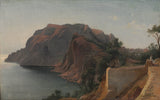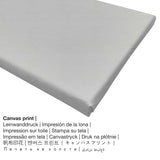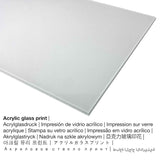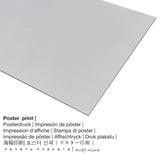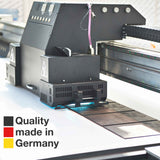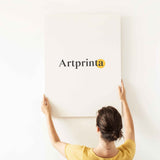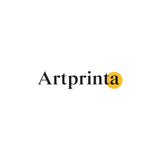Jean Achille Benouville, 1845 - Capri - mbipụta nka mara mma
Ụtụ gụnyere. Mbupu gbakọrọ na ndenye ọpụpụ.
In 1845 Jean Achille Benouville created the painting. The work of art has the size: Framed: 43 x 60 x 6 cm (16 15/16 x 23 5/8 x 2 3/8 in); Unframed: 28,1 x 44,7 cm (11 1/16 x 17 5/8 in) and was made with the Usoro oil on fabric. It was inscribed with the following text: "signed lower right: Achille Benouville". Moveover, this artwork can be viewed in in the Ụlọ ihe ngosi nka nke Cleveland nchịkọta nka dijitalụ na Cleveland, Ohio, United States nke America. Site n'ikike nke Velọ ihe ngosi nka nke Cleveland (nwere ikike: ngalaba ọha). Ebe kredit nke ọrụ nka: Maazị na Oriakụ William H. Marlatt Fund. Nhazi nke mmepụta dijitalụ dị na odida obodo format na akụkụ ruru nke 3: 2, nke pụtara na ogologo bụ 50% ogologo karịa obosara.
Họrọ ngwa ngwaahịa gị
Maka ngwaahịa ọ bụla anyị na-enye ihe dị iche iche & nha. Ya mere, anyị na-enye gị ohere ịhọrọ n'ime nhọrọ ndị a:
- Kwaaji: A canvas print, not to be confused with a canvas painting, is a digital image applied onto canvas. A canvas produces a plastic impression of three dimensionality. What is more, canvas produces a cosy and enjoyable impression. Canvas prints are relatively low in weight, which means that it is quite simple to hang the Canvas print without extra wall-mounts. Hence, canvas prints are suitable for any type of wall.
- Mbipụta nke aluminom: An Aluminium Dibond print is a print material with an outstanding effect of depth, creating a modern impression thanks to a surface , which is not reflective. The colors are luminous in the highest definition, the fine details of the print appear crisp and clear, and there’s a matte appearance that you can literally feel.
- Ugogbe acrylic ebipụtara: An acrylic glass print, often referred to as a UV print on plexiglass, will convert your original artwork into home décor and is a viable alternative option to dibond and canvas fine art replicas. The work of art is being manufactured thanks to state-of-the-art UV direct print technology. The image effect of this are intense, sharp colors.
- Akwụkwọ mmado ebipụtara (akwa akwa akwa): A poster print is a printed flat canvas with a granular texture on the surface, that resembles the original masterpiece. It is best suited for framing the art copy in a personal frame. Please bear in mind, that depending on the absolute size of the poster print we add a white margin of something between 2 - 6cm around the print motif in order to facilitate the framing.
Nkwupụta iwu: We try what we can in order to depict our products as accurate as it is possible and to display them visually on the respective product detail pages. At the same time, the colors of the print products and the print result might diverge somehwat from the image on the device's screen. Depending on your screen settings and the condition of the surface, not all color pigments are printed as realisitcally as the digital version depicted here. Because all the art reproductions are processed and printed manually, there may also be slight deviations in the exact position and the size of the motif.
Ngwaahịa a
| Nkewa ngwaahịa: | ọmarịcha nka |
| Usoro mmeghari: | mmeputakwa n'ụdị dijitalụ |
| Usoro mmepụta: | Mbipụta UV ozugbo |
| Mmalite ngwaahịa: | emepụtara na Germany |
| Ụdị ngwaahịa: | a na-achọ |
| Ihe eji eme atụmatụ: | ihe ndozi mgbidi, foto mgbidi |
| Nhazi nka nka: | nhazi odida obodo |
| Oke akụkụ onyonyo: | 3: 2 (ogologo: obosara) |
| Ihe: | ogologo bụ 50% ogologo karịa obosara |
| Nhọrọ dị: | akwụkwọ mmado (akwụkwọ kwaaji), mbipụta ọla (aluminium dibond), mbipụta iko acrylic (nke nwere ezigbo mkpuchi iko), mbipụta akwụkwọ. |
| Mpempe akwa akwa (akwa akwa na etiti ihe ndọtị) nha: | 30x20cm - 12x8", 60x40cm - 24x16", 90x60cm - 35x24", 120x80cm - 47x31", 150x100cm - 59x39" |
| Mpempe iko acrylic (nwere ezigbo mkpuchi iko) nha dị iche iche: | 30x20cm - 12x8", 60x40cm - 24x16", 90x60cm - 35x24", 120x80cm - 47x31", 150x100cm - 59x39" |
| Nhọrọ nke mbipụta akwụkwọ mmado (akwụkwọ kwaaji): | 60x40cm - 24x16", 90x60cm - 35x24", 120x80cm - 47x31" |
| Mpempe aluminom (aluminium dibond ihe) nha: | 30x20cm - 12x8", 60x40cm - 24x16", 90x60cm - 35x24", 120x80cm - 47x31" |
| Nhazi mbipụta nka: | na-enweghị etiti |
Nkọwa ahaziri nke ọrụ nka
| Akụkụ nka: | "Capri" |
| Nhazi: | sere |
| Category: | nkà nke oge a |
| Time: | 19th narị afọ |
| Afọ nka: | 1845 |
| Afọ nka: | gbara afọ 170 |
| Ọkara nke ihe osise izizi: | mmanụ na akwa ákwà |
| Nha izizi (ọrụ nka): | Nhazi: 43 x 60 x 6 cm (16 15/16 x 23 5/8 x 2 3/8 na); Edebereghị: 28,1 x 44,7 cm (11 1/16 x 17 5/8 na) |
| Akara aka nka nka: | signed lower right: Achille Benouville |
| Egosiputara na: | Velọ ihe ngosi nka nke Cleveland |
| Ebe ngosi nka: | Cleveland, Ohio, United States nke America |
| Ibe weebụ: | www.clevelandart.org |
| Licensedị ikike: | ngalaba ọha |
| Site n'aka: | Velọ ihe ngosi nka nke Cleveland |
| Ebe kredit nke ọrụ nka: | Maazị na Oriakụ William H. Marlatt Fund |
Banyere omenka
| Aha onye nka: | Jean Achille Benouville |
| A makwaara dịka: | Jean Achille Benouville, benouville achille, Benouville Jean Achille, A. Benoville, Benouville Jean-Achille, Benouville |
| Gender: | nwoke |
| Obodo onye nka: | French |
| Ọrụ nke onye na-ese ihe: | onye na-ese ihe |
| Obodo onye nka: | France |
| nhazi ọkwa: | omenkà nke oge a |
| Akwụsị: | 76 afọ |
| Afọ ọmụmụ: | 1815 |
| Nwụrụ n'afọ: | 1891 |
Nwebiisinka © | Artprinta.com (Artprinta)
Ngosipụta ihe osise sitere na webụsaịtị ihe ngosi nka (© Nwebiisinka - site na Cleveland Museum of Art - www.clevelandart.org)
Located in the Mediterrean Sea, south of Rome, the island of Capri has been famous since Roman times for its spectacular scenery and mild climate. In the 19th century it became the home of many European nobles, and attracted artists from across the continent. Here Benouville captured the beauty of the island's rocky coastline, focusing his attention on a path leading toward the city of Capri and past the rocky outcropping of Monte Solaro. Fascinated by the Italian landscape, Benouville spent years in Italy drawing and painting the countryside. From 1838 to 1845 he made at least three trips there, and in 1845, after winning the Prix de Rome-a fellowship allowing promising artists to study in that city-spent much of the next 25 years in Italy. Although trained to paint landscapes in a very formal manner, after leaving France Benouville began to paint his subjects with a much more personal, nontraditional approach. This may account for this picture's unusual composition, in which much of the canvas is given to indistinct, but beautifully painted stone, sky, and water.

